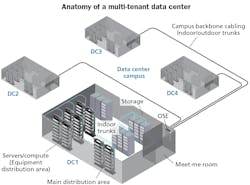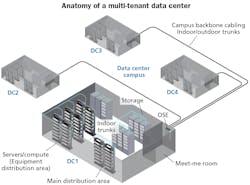How to cable a multi-tenant data center
By Juan Penaranda, Corning
Gartner predicts that by 2025, 80% of companies will migrate entirely away from on-premises data centers with the current trend of moving workloads to multitenant data centers, hosting, and the cloud leading them to shut down their traditional data center.
Most terms in telecom can go by two equally valid names, not to mention countless acronyms. The multitenant data center or colocation space is no exception. In this article we’ll stick with MTDC, but regardless of name, this space represents a rapidly growing percentage of data centers worldwide.
Today we’re living in the perfect storm, where we need to store and manage increasing amounts of data, while also keeping the resources and cost at a minimum. Did we mention the extra requirement to scale flexibly? Keeping a data center fully optimized while eliminating latency, reducing downtime, and maintaining compliance with ever-evolving standards is quite the challenge. Countless businesses answer this need with MTDCs. They find themselves caught between needing a more-efficient and flexible option than a private data center, but also requiring more control than that offered by the cloud.
What is a multitenant data center or colocation?
As defined by searchmicroservices.com, “A multitenant data center/colocation is a data center facility in which a business can rent space for servers and other computing hardware.” Simply put, an MTDC is no more than pure real-estate that then sublets space out to a customer and supports their building, cooling, power, bandwidth, and physical security requirements. Customers have historically done this by building their own data centers, but the market has now shifted to a considerable portion of private enterprise customers using MTDCs to host and manage their data center facilities. They lease by rack, cabinet, cage, or an entire data hall.
Outsourcing to an MTDC can be all, or a portion of, a company’s data center solution. Many customers leverage the hybrid IT model. This means an organization provides and manages some resources in-house (by building their own data center), while also using an MTDC or cloud-based service for their other data storage needs. This can help customers scale as needed or mitigate risk via redundancies. Considering moving your data to an MTDC facility? Resources are available to help ensure the facility is future-ready.
Outside plant cabling
To properly highlight how to cable an MTDC, we’ll start with the outside plant (OSP) options an MTDC may have to make. To keep it straightforward, we’ll focus on singlemode applications (based on the distances we’ve been seeing) with three families of cables that could be used interchangeably. There’s loose-tube cable, which is what most of the community is familiar with, given it’s been around for more than 40 years. If you are at or below counts of 144 fibers, then loose tube is perfectly suitable. Anything above a fiber count of 144 makes the difference in splice time vs. ribbon cable start to become a bigger factor. Now, if we’re starting to get fiber counts above 288, then a ribbon cabling model starts to make more business sense.
Two OSP solutions are especially relevant in the MTDC space. Microducts are a great “pay-as-you-grow” model for MTDCs, while data center interconnects offer the extreme densities required to connect multiple data center campuses.
Microducts are miniaturized plastic conduits that subdivide internal duct space into smaller compartments, inside of which micro cables can be installed by blowing, jetting or pushing. If you’re using a duct system with several paths, micro cabling allows you to start hitting more extreme densities. Another way microducts are of interest to MTDCs is that they could have physically separate pathways for each tenant and still scale flexibly as they bring customers online.
Spearheaded by the hyperscale data center campuses, the data center interconnect application has emerged as an important segment in the network landscape. MTDCs are quickly adopting this solution and have started to connect several buildings, between which they require adequate bandwidth. What does this mean? Well now the stakes are higher, as any mistake compromises not just a couple of fibers, but rather at least 288. There’s no way around the fact that high fiber counts plus increased risk equals increased installation time.
Meet-me room
A meet-me room can also be called a telecom room, entrance room, or carrier room. This is the section of a data center where the OSP cable is terminated before going out to either the main distribution area or cage. Field terminations and strict service level agreements result in a smaller margin for error. At a high level, the biggest goal of an MTDC is to mitigate risk. Network downtime can range from an irritated end user to a several-million-dollar liability.
In the meet-me room, an MTDC transitions the OSP cable to the inside plant cable. The solutions tend to be field-terminated and rely on splicers that are either supplied by the MTDC or outsourced. It’s important to use a solution that optimizes splicing efficiency, both to increase ease of deployment as well as decreasing labor costs. If the fiber counts coming into the MTDC are low density, then single-fiber splicing, either mechanical or fusion, makes sense. Considering the emphasis on risk in the MTDC space, fusion splicing makes more sense given it provides better protection against cable failure and weak signals. If we’re looking at higher fiber counts coming into the meet-me room, then the economies of scale would steer us toward mass fusion splicing. Taking a step back to look for a manufacturer that offers a variety of field-termination options is critical to matching the needs of individual MTDCs.
On a complementary note to the solutions, many MTDCs can’t grow their facilities staff fast enough; this results in a relatively novice workforce. Look for a manufacturer that offers training on all types of deployments, from the prewire all the way to the cage. It’s helpful to know that solution providers can offer a range of free services, such as looking over the bill of materials, or on-site service if something doesn’t go as planned during installation.
Main distribution area
The main distribution area can also be called the crossconnect and is the central point of distribution for the data center’s structured cabling system. The easiest way to mitigate risk is to take a preventative route, but what does this mean? By investing in a structured cabling solution early and using a main distribution area to facilitate easy cabling (including moves, adds and changes [MACs]), customers can be brought online in as little as two or three days. No matter how good your base cabling is, spending time grabbing different jumper lengths, splicers, and other equipment can become quite stressful. The key to minimizing this pressure is to invest in a solution with simplified product sets. Don’t want to track down several different jumper lengths? Look for a solution that only requires one length of jumpers for all crossconnect scenarios across two frames.
Not only is organization beneficial to the MACs of current customers, but organized cabling also attracts prospective end users. When MTDCs want to find a way to differentiate themselves, what better way is there than to confidently give customer tours? Many times, this is the first impression and any sort of clutter could be the deciding factor between a multi-year contract and an email saying they’ve gone elsewhere.
Caged area
The caged area is where the end user houses their infrastructure. The main challenges to address here are how end users typically get billed and how well the infrastructure is set for the future. Looking at the passive infrastructure specifically, the goal is to maximize rack space so there is less space being taken up and therefore less to be charged for in the cage. With customers being billed on space and power, solution density is top-of-mind when leasing space in an MTDC. With higher densities comes less flexibility to make changes; make sure to choose a solution that maximizes density while maintaining ease of use. By using a port breakout solution, it’s possible to densify your infrastructure while saving on power. This allows a 40G port to act as 4 individual 10G ports, which reduces the number of chassis and line cards by two thirds (resulting in less power consumed) and offers a reduction in the cost per port to deploy.
An important part of looking for the right solution is to consider how prepared and planned out a system is for the future. There exist a copious amount of 2- and 8-fiber solutions on the market for both singlemode and multimode fibers. How did we get here? Well, cabling was easy during the transition from 1G to 10G because everything was operating across duplex fibers. Once the market reached 40G, life became a little more hectic. For the first time, the decision between 2- and 8-fiber systems needed to be re-evaluated. There were, and are, many factors to consider such as cost, applications, and what the user is trying to do. MTDCs typically run at lengths that work best with parallel optics. A benefit to parallel optics comes from using a port breakout methodology. This can help triple the switch ports, allowing for bigger networks or more hosts relative to the switch density.
Looking forward
In the MTDC space, from the OSP cable to the caged area, it’s important to offer flexible solutions for all types of applications. New trends in edge computing, 5G, virtual reality, augmented reality, and artificial intelligence are pushing the bandwidth needs of all customer segments. By allocating the correct amount of cage space and anticipating the fiber counts that customers will ultimately come to expect, MTDCs can differentiate themselves from the competition.
The companies that will stand out and gain in this market are the ones that proactively invest in their structured cabling infrastructure. This will become increasingly important as enterprises and service providers create new strategies to grow and expand their digital business capabilities and results. Future trends, such as edge data centers and 5G, will reward the companies that offer interconnection-oriented facilities as new applications change the way we create, collect, process and analyze data.
Juan Penaranda focuses on data center applications marketing with Corning Optical Communications, specializing in the multitenant data center space. He analyzes this market and focuses on how trends such as artificial intelligence, the Internet of Things, machine learning, autonomous vehicles and 5G will affect this market segment. Penaranda’s tasks include developing content for presentations, white papers and articles. He previously was in the global rotational program at Corning Optical Communications.


